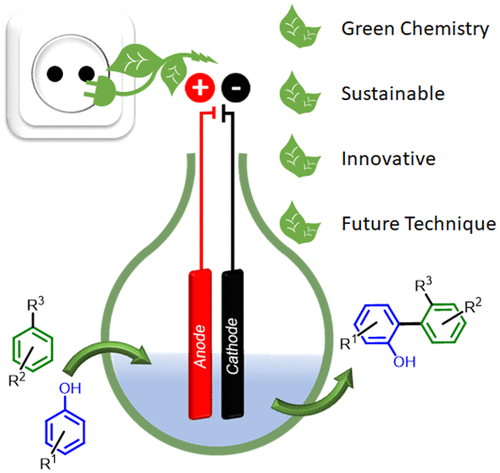当前位置:
X-MOL 学术
›
Acc. Chem. Res.
›
论文详情
Our official English website, www.x-mol.net, welcomes your
feedback! (Note: you will need to create a separate account there.)
A Decade of Electrochemical Dehydrogenative C,C-Coupling of Aryls.
Accounts of Chemical Research ( IF 16.4 ) Pub Date : 2019-12-18 , DOI: 10.1021/acs.accounts.9b00511 Johannes L Röckl 1 , Dennis Pollok 2 , Robert Franke 3, 4 , Siegfried R Waldvogel 1, 2
Accounts of Chemical Research ( IF 16.4 ) Pub Date : 2019-12-18 , DOI: 10.1021/acs.accounts.9b00511 Johannes L Röckl 1 , Dennis Pollok 2 , Robert Franke 3, 4 , Siegfried R Waldvogel 1, 2
Affiliation

|
The importance of sustainable and green synthetic protocols for the synthesis of fine chemicals has rapidly increased during the last decades in an effort to reduce the use of fossil fuels and other finite resources. The replacement of common reagents by electricity provides a cost- and atom-efficient, environmentally friendly, and inherently safe access to novel synthetic routes. The selective formation of carbon-carbon bonds between two distinct substrates is a crucial tool in organic chemistry. This fundamental transformation enables access to a broad variety of complex molecular architectures. In particular, the aryl-aryl bond formation has high significance for the preparation of organic materials, drugs, and natural products. Besides well-known and well-established reductive- and oxidative-reagent-mediated or transition-metal-catalyzed coupling reactions, novel synthetic protocols have arisen, which require fewer steps than conventional synthetic approaches. Electroorganic conversions can be categorized according to the nature of the electron transfer processes occurring. Direct transformations at inert electrode materials are environmentally benign and cost-effective, whereas catalytic processes at active electrodes and mediated electrosynthesis using an additional soluble reagent can have beneficial properties in terms of selectivity and reactivity. In general, these conversions require challenging optimization of the reaction parameters and the appropriate cell design. Galvanostatic reactions enable fast conversions with a rather simple setup, whereas potentiostatic electrolysis may enhance selectivity. This Account discusses the development of seminal carbon-carbon bond formations over the past two decades, focusing on phenols leading to precursors for ligands in, e.g., hydroformylation reaction. A key element in the success of these electrochemical transformations is the application of electrochemically inert, non-nucleophilic, highly fluorinated alcohols such as 1,1,1,3,3,3-hexafluoro-2-propanol (HFIP), which exhibit a large potential window for transformations and enable selective cross-coupling reactions. This selectivity is based on the capability of HFIP to stabilize organic radicals. Inert, carbon-based and metal-free electrode materials like graphite or boron-doped diamond (BDD) open up novel electroorganic pathways. Furthermore, novel active electrode materials have been developed to enable intra- and intermolecular dehydrogenative coupling reactions of electron-rich aryls. The application of 2,2'-biphenol derivatives as ligand components for catalysts requires reactions to be carried out on larger scale. In order to achieve this, continuous flow transformations have been established to overcome the drawbacks of heat transfer, overconversion, and conductivity. Modular cell designs enable the transfer of a broad variety of electroorganic conversions into continuous processes. Recent results demonstrate the application of organic electrochemistry to natural product synthesis of the pharmaceutically relevant opiate alkaloids (-)-thebaine or (-)-oxycodone.
中文翻译:

芳基化合物的电化学脱氢C,C联结的十年。
在过去的几十年中,为了减少化石燃料和其他有限资源的使用,可持续和绿色合成方案对精细化学品合成的重要性迅速增加。用电代替普通试剂可提供一种成本和原子效率高,环保且天生就安全的新型合成途径。在两个不同的底物之间选择性形成碳-碳键是有机化学中的关键工具。这种基本的转变使人们能够访问各种各样的复杂分子结构。特别地,芳基-芳基键的形成对于有机材料,药物和天然产物的制备具有高度意义。除了众所周知的和公认的还原性和氧化性试剂介导的或过渡金属催化的偶联反应之外,还出现了新颖的合成方案,与常规合成方法相比,所需步骤更少。可以根据发生的电子转移过程的性质对电有机转化进行分类。惰性电极材料上的直接转化对环境无害且具有成本效益,而活性电极上的催化过程和使用其他可溶性试剂介导的电合成在选择性和反应性方面可以具有有益的特性。通常,这些转化需要对反应参数和合适的电池设计进行具有挑战性的优化。恒电流反应可通过相当简单的设置实现快速转化,恒电位电解可以提高选择性。该报告讨论了过去二十年中精油碳-碳键形成的发展,重点是在例如加氢甲酰化反应中导致配体前体的酚。这些电化学转化成功的关键因素是应用电化学惰性,非亲核,高度氟化的醇,例如1,1,1,3,3,3-六氟-2-丙醇(HFIP),潜在的大转换窗口,可以进行选择性的交叉偶联反应。该选择性基于HFIP稳定有机自由基的能力。惰性,碳基且不含金属的电极材料(例如石墨或掺硼金刚石(BDD))开辟了新颖的有机电通路。此外,已经开发出新颖的活性电极材料以实现富电子芳基的分子内和分子间脱氢偶联反应。2,2′-双酚衍生物作为催化剂的配体组分的应用要求反应要大规模进行。为了实现这一点,已经建立了连续的流转化以克服热传递,过度转化和传导性的缺点。模块化的电池设计可将多种有机电子转化转移到连续过程中。最近的结果证明了有机电化学在药学上相关的鸦片生物碱(-)-蒂巴因或(-)-羟考酮的天然产物合成中的应用。2,2′-双酚衍生物作为催化剂的配体组分的应用要求反应要大规模进行。为了实现这一点,已经建立了连续的流转化以克服热传递,过度转化和传导性的缺点。模块化的电池设计可将多种有机电子转化转移到连续过程中。最近的结果证明了有机电化学在药学上相关的鸦片生物碱(-)-蒂巴因或(-)-羟考酮的天然产物合成中的应用。2,2′-双酚衍生物作为催化剂的配体组分的应用要求反应要大规模进行。为了实现这一点,已经建立了连续的流转化以克服热传递,过度转化和传导性的缺点。模块化的电池设计可将多种有机电子转化转移到连续过程中。最近的结果证明了有机电化学在药学上相关的鸦片生物碱(-)-蒂巴因或(-)-羟考酮的天然产物合成中的应用。和导电性。模块化的电池设计可将多种有机电子转化转移到连续过程中。最近的结果证明了有机电化学在药学上相关的鸦片生物碱(-)-蒂巴因或(-)-羟考酮的天然产物合成中的应用。和导电性。模块化的电池设计可将多种有机电子转化转移到连续过程中。最近的结果证明了有机电化学在药学上相关的鸦片生物碱(-)-蒂巴因或(-)-羟考酮的天然产物合成中的应用。
更新日期:2019-12-19
中文翻译:

芳基化合物的电化学脱氢C,C联结的十年。
在过去的几十年中,为了减少化石燃料和其他有限资源的使用,可持续和绿色合成方案对精细化学品合成的重要性迅速增加。用电代替普通试剂可提供一种成本和原子效率高,环保且天生就安全的新型合成途径。在两个不同的底物之间选择性形成碳-碳键是有机化学中的关键工具。这种基本的转变使人们能够访问各种各样的复杂分子结构。特别地,芳基-芳基键的形成对于有机材料,药物和天然产物的制备具有高度意义。除了众所周知的和公认的还原性和氧化性试剂介导的或过渡金属催化的偶联反应之外,还出现了新颖的合成方案,与常规合成方法相比,所需步骤更少。可以根据发生的电子转移过程的性质对电有机转化进行分类。惰性电极材料上的直接转化对环境无害且具有成本效益,而活性电极上的催化过程和使用其他可溶性试剂介导的电合成在选择性和反应性方面可以具有有益的特性。通常,这些转化需要对反应参数和合适的电池设计进行具有挑战性的优化。恒电流反应可通过相当简单的设置实现快速转化,恒电位电解可以提高选择性。该报告讨论了过去二十年中精油碳-碳键形成的发展,重点是在例如加氢甲酰化反应中导致配体前体的酚。这些电化学转化成功的关键因素是应用电化学惰性,非亲核,高度氟化的醇,例如1,1,1,3,3,3-六氟-2-丙醇(HFIP),潜在的大转换窗口,可以进行选择性的交叉偶联反应。该选择性基于HFIP稳定有机自由基的能力。惰性,碳基且不含金属的电极材料(例如石墨或掺硼金刚石(BDD))开辟了新颖的有机电通路。此外,已经开发出新颖的活性电极材料以实现富电子芳基的分子内和分子间脱氢偶联反应。2,2′-双酚衍生物作为催化剂的配体组分的应用要求反应要大规模进行。为了实现这一点,已经建立了连续的流转化以克服热传递,过度转化和传导性的缺点。模块化的电池设计可将多种有机电子转化转移到连续过程中。最近的结果证明了有机电化学在药学上相关的鸦片生物碱(-)-蒂巴因或(-)-羟考酮的天然产物合成中的应用。2,2′-双酚衍生物作为催化剂的配体组分的应用要求反应要大规模进行。为了实现这一点,已经建立了连续的流转化以克服热传递,过度转化和传导性的缺点。模块化的电池设计可将多种有机电子转化转移到连续过程中。最近的结果证明了有机电化学在药学上相关的鸦片生物碱(-)-蒂巴因或(-)-羟考酮的天然产物合成中的应用。2,2′-双酚衍生物作为催化剂的配体组分的应用要求反应要大规模进行。为了实现这一点,已经建立了连续的流转化以克服热传递,过度转化和传导性的缺点。模块化的电池设计可将多种有机电子转化转移到连续过程中。最近的结果证明了有机电化学在药学上相关的鸦片生物碱(-)-蒂巴因或(-)-羟考酮的天然产物合成中的应用。和导电性。模块化的电池设计可将多种有机电子转化转移到连续过程中。最近的结果证明了有机电化学在药学上相关的鸦片生物碱(-)-蒂巴因或(-)-羟考酮的天然产物合成中的应用。和导电性。模块化的电池设计可将多种有机电子转化转移到连续过程中。最近的结果证明了有机电化学在药学上相关的鸦片生物碱(-)-蒂巴因或(-)-羟考酮的天然产物合成中的应用。











































 京公网安备 11010802027423号
京公网安备 11010802027423号